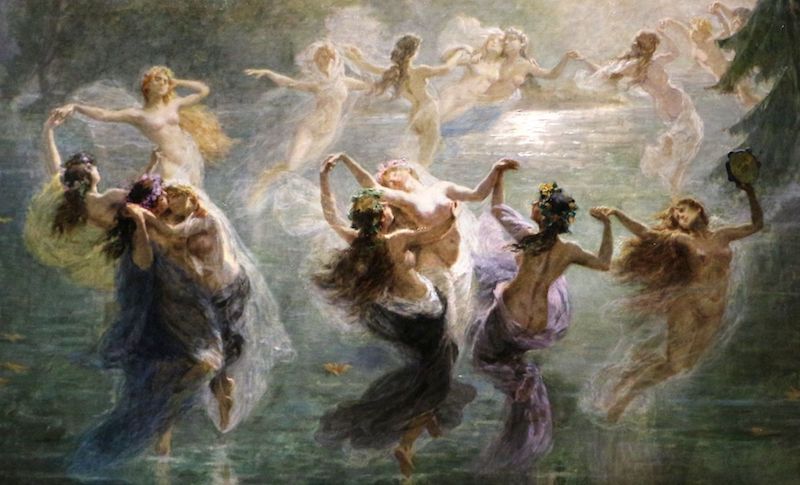a free ecstatic dance program

This practice was originally offered as a free email course in 2018. I have decided to publish the practice here so that people can do it whenever they like.
What is Ekstasis
Ekastsis is the Greek work for ecstasy. It’s a concept that exists heavily within Greek philosophy and religion and literally means “to stand outside oneself.” It is an altered state of consciousness or trance state in which one is believed to be able to achieve oneness with the divine. The use of altered states of consciousness as a means of assisting with spirit communion has been present in practically all mystical traditions throughout history. There are numerous ways people have used to enter this state historically including: meditation, ascetic practices such as fasting and mortification of the flesh, drumming, movement and dance, BDSM, and through the ritual use of entheogenic plants. It is an ideal state for performing any kind of spell-work, spirit communication, divination, or creating art because you are more receptive. It is the state in which the Oracle at Delphi delivered prophecy and Catherine of Siena dictated volumes of channeled prayers.
While the focus of ecstatic practices is transcendence, the practice of ecstatic dance is inherently embodied. When we use movement to enter this state, we affirm that it is THROUGH the body (and through the human, physical experience, and not through the denial of it) that we achieve spiritual union. Body and spirit are inextricably linked and to deny either is to deny the fullness of existence. Therefore, I personally prefer to think of the trance state as one in which we “expand” rather than “transcend” the self.
The Basic Practice
The practice that I’m going to lay out for you here is actually quite simple and consists of only 4 steps:
- Check in with your body and see how you are feeling
- Choose a song
- Move your body for the length of the song
- Write down a few sentences about how it went for you
That’s it! I’m going to elaborate on these steps further but this is the basic, bare-minimum practice that you are going to be committing to. You are welcome to ritualize this in any way you like, and make it as elaborate or long as you choose, but the basic practice is so simple for two important reasons:
- We are striving for consistency over intensity here. It’s better to do something every day for 3 minutes than once a week for 20 minutes. Making it as simple and easy to do as possible will help you stick with it for the full 30 days. If you feel called to do more please do! The basic practice is the only thing that is required, however.
- The second reason, and this is the most vital one: YOUR BODY DICTATES THE PRACTICE. I considered doing prompts for the days but that would interfere with the crucial process of listening to your body and letting it inform you how it wants to move that day in the moment.

The Steps in Detail
- Check in with your body and see how you are feeling: This one is pretty self-explanatory. Spend a moment assessing how you feel mentally and physically. This is just a brief assessment. Are you tired, angry, depressed, ill, horny? Make a note of that because this will inform how you are moving today in terms of the intensity, pace, and quality of movement.
- Choose a song: Use step one to inform your song choice. Let your intuition guide you. The song can be as long as you want, but try and pick something that is at least 3-5 minutes long. If that seems short, remember we are aiming for a small and manageable routine to start and to keep you committed and not overwhelmed. You can always go longer if you want! I personally think it’s best to choose music that is primarily instrumental, or if it has vocals, that they are minimal and repetitive, or in another language than your native one so that they are not distracting. I create all of my music this way so that it can be used for this purpose. Try not to overthink this or spend too much time obsessing over finding the perfect song. Just pick something and go with it. It can be helpful to pick out some different types of music with different moods and energies ahead of time so you already have a selection to pick from.
- Move your body for the length of the song: You are going to be doing completely free-form movement here. This is dance but it’s not necessarily going to look like it in any traditional sense. If you have never done this before you will probably feel silly and part of this practice is getting over that. DO NOT WORRY ABOUT LOOKING COOL, JUST MOVE. Try to avoid looking in the mirror while you do this. You will find that as you go along, your body will let you know how it wants to move. You will feel compelled to make all kinds of different, and sometimes bizarre movements. There is no wrong way to do this other than to not do it at all, or to overthink it. Here are some different ways this has looked for me to give you an idea: shaking, repetitive motions, explosive jumping, wriggling on the floor, spinning, writhing, lying down completely and just moving my legs or head, sitting in a chair or the ground and swaying, moving just one arm, or one hand. This practice is infinitely adaptable and should absolutely be modified to fit your personal level of health and mobility. Remember again the number one rule: YOUR BODY DICTATES THE PRACTICE. General disclaimer of how I am not your doctor and it is your responsibility to do this work in a way that supports your own health.
- Write down a few sentences about how it went for you: This last one is more optional but I highly recommend it. You can keep this journal in any way you like. It can be in a notebook or a note taking app, or you might chose to share your experience publicly on a blog or on social media. This is your personal practice and how you choose to record it is completely up to you. I found it really useful to go through my entries afterwords to reflect on the process and how it changed me over time. It also helps you to keep track of the days and to maintain personal accountability. These entries can also be as long as you want but try to write at least 1-2 sentences.
Here are a couple of my entries from when I blogged about doing this practice to give you an idea:
Day 9:
There was a blizzard in New York today and the whole city felt quiet and still. I attempted to draw that quietness and stillness into my body and my movement.
Day 10:
I find myself incredibly exhausted and depressed lately so I am exploring ways of making my dance about these feelings and states. What does tired and depressed look like as a dance?
Day 16:
Practice was agressive today. I had a lot of energy to burn off. Tuesday is the day of Mars and it tends to bring out a lot of irritation in me.
Now that you know the basic steps you are ready to get started. You are going to be doing this practice at least once a day, at any time of day that you like for a full 30 days. It can be done almost anywhere, though obviously somewhere private is preferable. I have done it outdoors as well as in tiny bedrooms wearing headphones. You are welcome to practice this with other people, but ONLY if doing so will not make you self-conscious in any way because you really need to free yourself of judgement to do this work effectively.
Once you finish the course, here are a few suggestions for how to take the practice further:
- Try going for longer: the longer you move, the deeper into the trance state you can go and the more chance for insight and communion
- Consider incorporating music from your ancestral traditions as an act of ancestor veneration
- Try doing the practice before performing divination or spellwork
- Incorporate entheogenic plants if that’s something you comfortable with
- Use the dance as a form of sympathetic magic, i.e. to embody what you wish to draw in or to “act out” what you wish to accomplish
- Practice aligning your movements with planetary and stellar energies
- Draw sigils into the earth or on the ground with chalk and dance over them to earth them
Additional Resources
Sweat Your Prayers: Movement As Spiritual Practice
Seidways: Shaking, Swaying and Serpent Mysteries
Dancing in the Streets: A History of Collective Joy
The Dancing Goddesses: Folklore, Archaeology, and the Origins of European Dance
The Brazen Vessel which includes an interview I did with Alkistis Dimech on dance and “the occulted body”
The Emerald Podcast: How Trance States Shape the World
Spotify Playlists
Our struggle then must begin with the re-appropriation of our body, the revaluation and rediscovery of its capacity for resistance, and expansion and celebration of its powers, individual and collective.
Dance is central to this re-appropriation. In essence, the act of dancing is an exploration and invention of what a body can do: of its capacities, its languages, its articulations of the strivings of our being. I have come to believe that there is a philosophy in dancing, for dance mimics the processes by which we relate to the world, connect with other bodies, transform ourselves and the space around us.
From dance we learn that matter is not stupid, it is not blind, it is not mechanical, but has its rhythms, has its language, and it is self-activated and self-organizing, Our bodies have reasons that we need to learn, rediscover, reinvent. We need to listen to their language as the path to our health and healing, as we need to listen to the language and rhythms of the natural world as the path to the health and healing of the earth. Since the power to be affected and to affect, to be moved and move, a capacity which is indestructible, exhausted only with death, is constitutive of the body, there is an immanent politics residing in it: the capacity to transform itself, others, and change the world.
Silvia Federici, In Praise of the Dancing Body